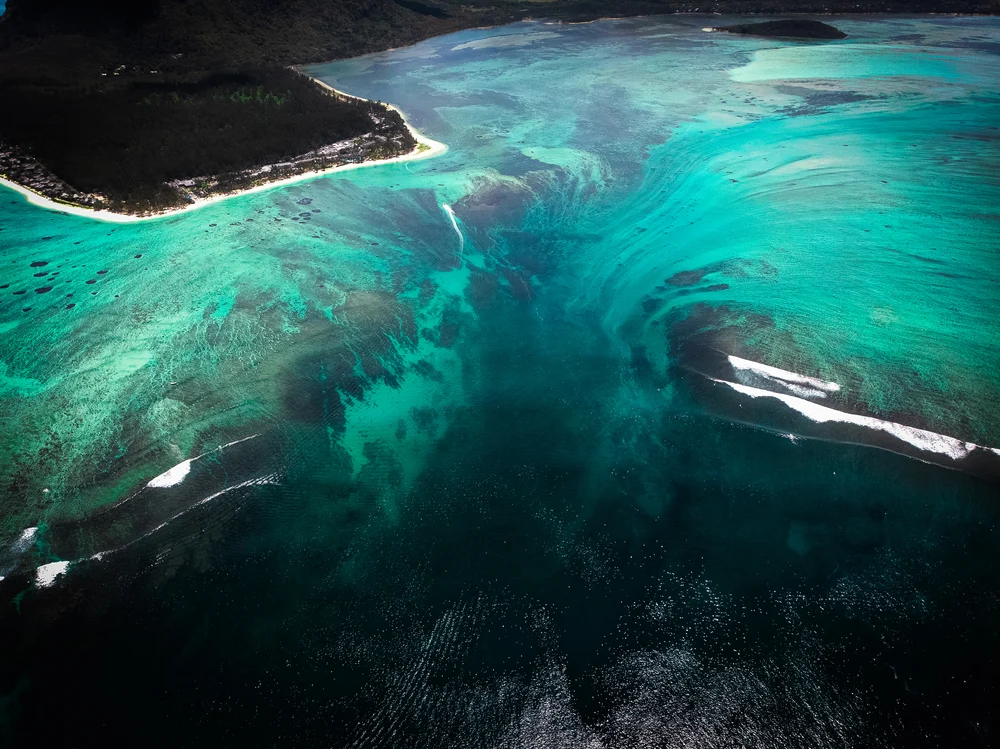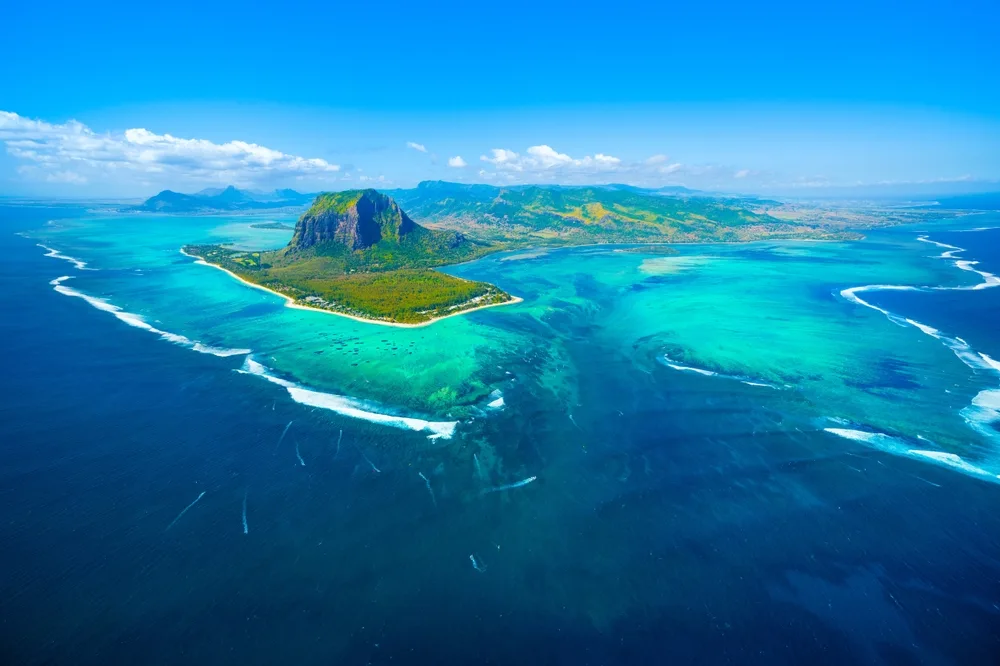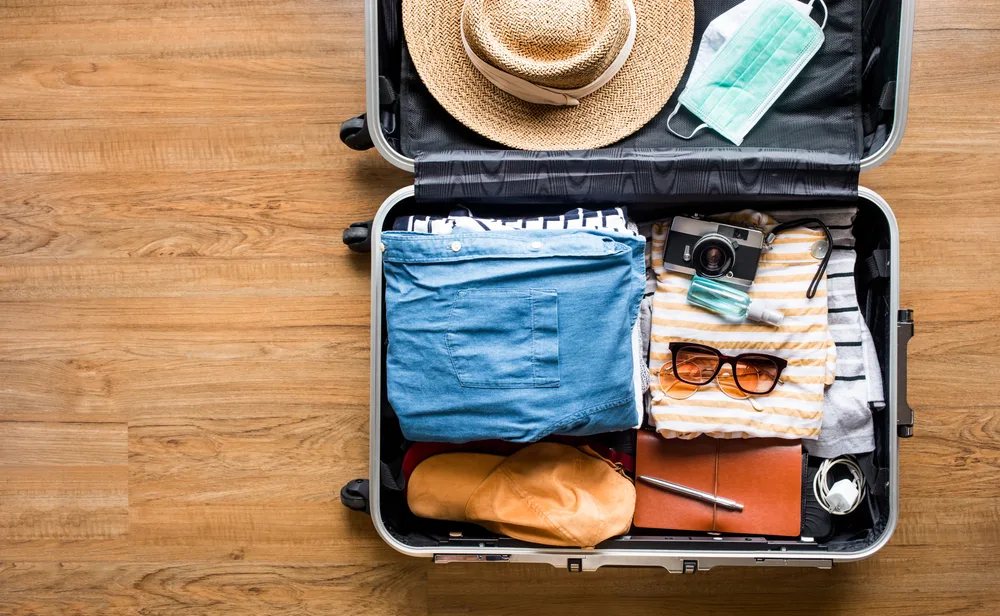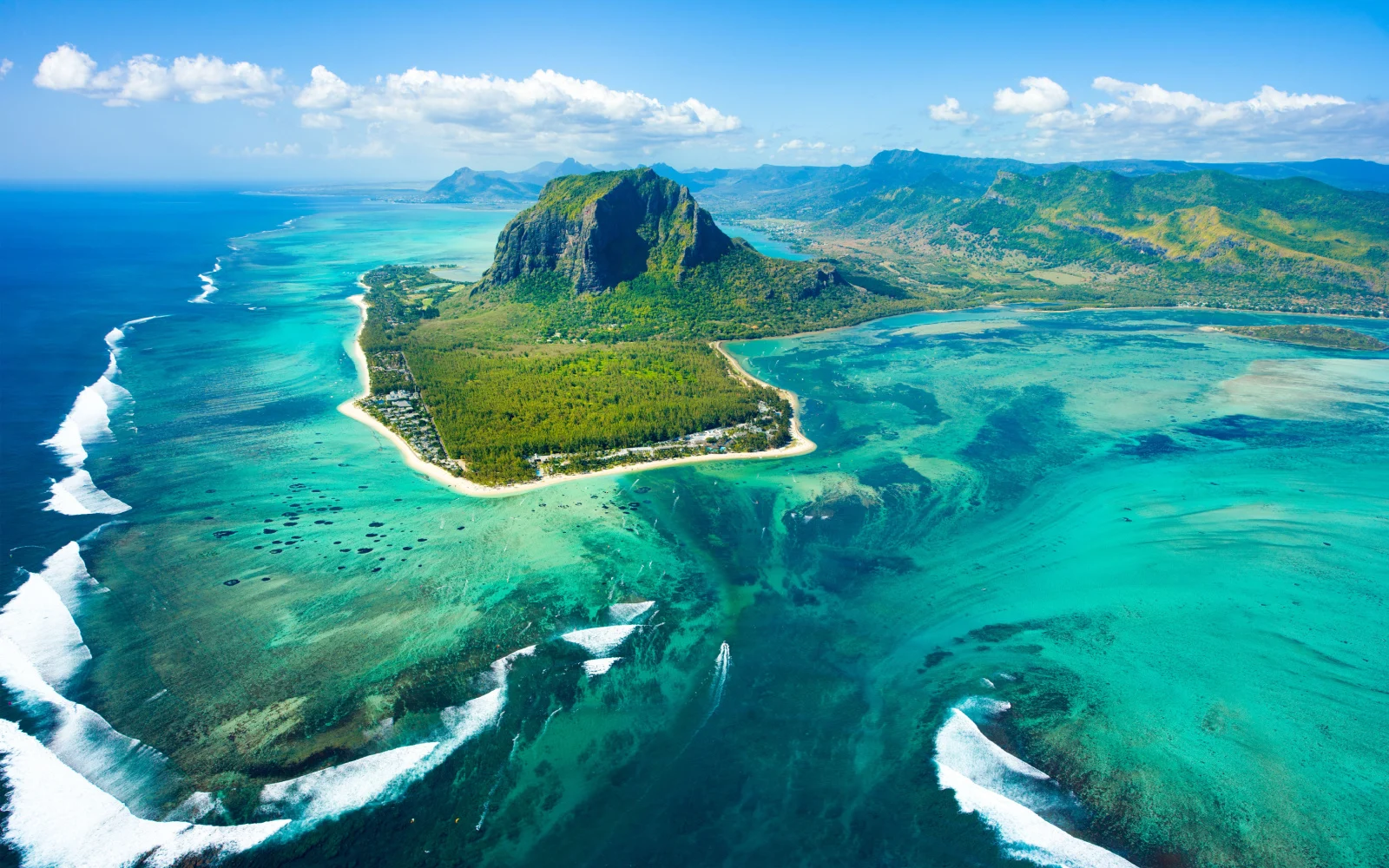Now, sure, waterfalls are a pretty common sight. But have you ever seen one… under the water?
If you’re like me, then the phrase “underwater waterfall” was all you needed to hear. Because either that’s impossible, or it’s something you need to see immediately (or maybe both)?
The truth is, this phenomenon does exist, but it’s probably not what you’re expecting.
Located on the far-flung island of Mauritius, an independent country that comprises several other islands and an archipelago, this sight is absolutely worth traveling deep into the Indian Ocean to see.
Let’s take a look at what it is, how it came to be, and how you can see it yourself. We’ll also touch on other activities to do on this beautiful island nation, as well as a few FAQs.
What Is the Underwater Waterfall?

Ihor Pokryshchenko/Shutterstock
The underwater waterfall isn’t actually a movement of water. In fact, the sea is very gentle in this spot, so you don’t need to worry about being sucked to your death if you boat over the top of it. (Not my first thought or anything.)
The “waterfall” is an illusion caused by silt and sand dropping off a ledge into the oceanic abyss below. This slow, steady movement creates what looks like falling water into the depths.
The result is a wondrous blue-green landscape, with aquamarine silt running from cliffs on two sides – much brighter on one than the other – into the darkening water below – then disappearing entirely.
How Was the “Waterfall” Created?
So, how did a marvel such as this come to be? Good question. Most landmasses belong to huge continents. However, there are some countries that exist outside of these giant landmasses, which sit on top of tectonic plates and very gradually fade at the edges down into the marine depths.
That’s not how it works for islands, though. These form over geologic hotspots, parts of the submarine crust that melt and allow magma to flow upward into the water, then harden.
This forms steep shelves on which islands sit. You can see this at work in places such as Hawaii or American Samoa.
The same is true for Mauritius, the main island in the eponymous country, as well as the other islands that make it up: Rodrigues Island and the members of the Cargados Carajos Shoals and the Agalega Islands.
Among these are the popular Île aux Cerfs, Hermitage Island, Gunner’s Quoin, and more. These small landmasses do not have gently sloping sides that gradually traverse the miles of depth down to the ocean floor.
Rather, they drop off sharply, so that if you were to swim out far enough, you’d suddenly find yourself drifting thousands of meters above empty space.
*shivers*
This shelf effect is what allows the underwater “waterfall” to exist, with sand and silt pouring off the landmass down into the chasm between the two shelves that make it up.
How Can You See It?

Myroslava Bozhko/Shutterstock
Unfortunately, this magnificent phenomenon is not really visible from the shore. In order to experience it, you need to be above it – either from the water or the air.
There are several ways to see the underwater waterfall. Perhaps the most spectacular is to do so by helicopter. If you’ve already come all the way to Mauritius, it’s worth spending the money to hop on a chopper and see it from above.
It’s spendy, though. A 15-minute helicopter ride costs about $160 per person, while an 80-minute island excursion that includes the waterfall among many other sights will cost about $550.
A private boat tour will likely prove cheaper.
These range hugely in price, depending on the size of your group, how long you charter the boat for, and what else you want to see. Plan to spend somewhere between $75 and $150 per person, on average.
What Else Is There to Do on Mauritius?
Happily, Mauritius is more than its waterfall. This island nation is home to around 1.2 million people, and as such boasts a stunning cultural blend hailing from India, Southeast Asia, Africa, China, and Europe.
Its unique geography ensures equally unique flora and fauna, with wilderness areas, coral reefs, and an 860-acre zoo/nature park by the name of Casela.
If you love natural sights, try:
- Le Morne Cultural Landscape, once used by runaway slaves for shelter
- Preybere Beach, where you can’t be nude, but you can be topless!
- Terres de 7 Couleurs, which you should just Google… we don’t want to rob you of the joy of discovery
- Black River Gorges National Park, which includes the gorgeous aboveground Alexandra Falls
- Flic-en-Flac, both a town and a beach – one of the longest and most unspoiled in the country
… and so much more.
You should also sample as much local cuisine as possible. Arguably the country’s best dish is the fish vendaye. It’s a savory mix of pickled fish, fried to perfection, then mixed with onions, turmeric, mustard, and more.
Paired with fresh bread, deeply buttered, it’s a national staple and well worth tasting at a few different restaurants. Now let’s take a look at a few of the most common FAQs about getting to and around Mauritius.
Frequently Asked Questions

HAKINMHAN/Shutterstock
Here are a few frequently asked questions about a trip to Mauritius:
How long does it take to get to Mauritius?
Getting to Mauritius will take more than a day from most American destinations. Plan to spend between 24 and 30 hours in transit.
Oddly, there doesn’t seem to be much of a difference in time between the West Coast and East Coast, which indicates that you’ll probably have to cool your heels in an airport somewhere along the way.
The best bet is to look for flights that give you enough of a stopover to see the sights wherever you are – e.g. Dubai, through which many itineraries pass.
How much does the average plane ticket cost?
Prices depend heavily on when you’re going, when you book, what airline you fly, and whether you’re using money or miles. For the most part, you can expect to pay around $1,000 for a ticket, if you price-shop and book your ticket well ahead of time.
What should I pack?
Mauritius is pleasant year-round. The hottest months are during the Northern Hemisphere winter, when it’s also rainy. The cool season is between June and September and is a very nice time to travel. It gets “cold” in August, when temps may drop as low as 66 degrees Fahrenheit or so.
As such, you’ll want to pull out your tropical wardrobe and All The Beach Things. Make sure to include comfortable walking shoes and shorts, however, since much of the island’s activity involves walking or hiking.
Mauritius is also buggy, so make sure to bring your bug spray. Don’t plan to stock up on it there, though: the island is an expensive place to buy toiletries. Instead, bring it with you, along with your sunblock, cosmetics, and over-the-counter medications.
When should I go?
Given the tropical nature of Mauritius, there’s not really a “bad” time to visit if you just like sun, sand, and surf. It’s temperate and pleasant most of the year.
However, the typical months for tropical travel for Americans run between November and March. Unfortunately, December through April constitute the rainy season in Mauritius, which could complicate your ability to see the waterfall.
The best time to come is outside of this window, if you can. Otherwise, just watch for clear weather when it’s safe to go out boating and snatch your chance!
Put the Underwater Waterfall on Your Agenda Today
If you’re looking for gorgeous weather, a unique culture, and a sight you’ll never forget, the underwater waterfall of Mauritius is well worth putting on your bucket list. Happy travels!



